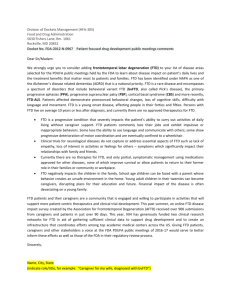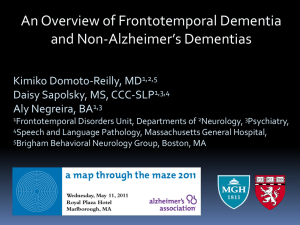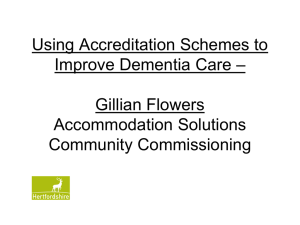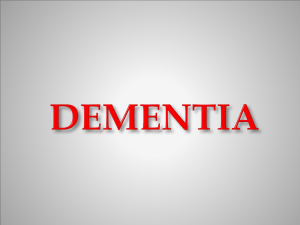Patients
advertisement
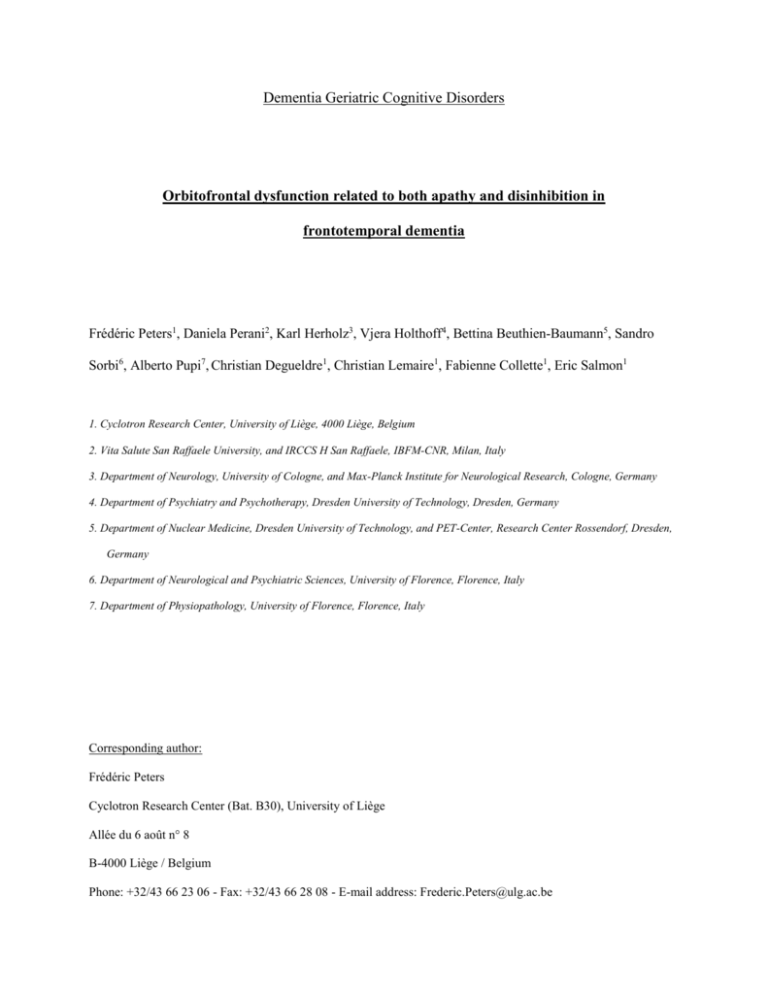
Dementia Geriatric Cognitive Disorders Orbitofrontal dysfunction related to both apathy and disinhibition in frontotemporal dementia Frédéric Peters1, Daniela Perani2, Karl Herholz3, Vjera Holthoff4, Bettina Beuthien-Baumann5, Sandro Sorbi6, Alberto Pupi7, Christian Degueldre1, Christian Lemaire1, Fabienne Collette1, Eric Salmon1 1. Cyclotron Research Center, University of Liège, 4000 Liège, Belgium 2. Vita Salute San Raffaele University, and IRCCS H San Raffaele, IBFM-CNR, Milan, Italy 3. Department of Neurology, University of Cologne, and Max-Planck Institute for Neurological Research, Cologne, Germany 4. Department of Psychiatry and Psychotherapy, Dresden University of Technology, Dresden, Germany 5. Department of Nuclear Medicine, Dresden University of Technology, and PET-Center, Research Center Rossendorf, Dresden, Germany 6. Department of Neurological and Psychiatric Sciences, University of Florence, Florence, Italy 7. Department of Physiopathology, University of Florence, Florence, Italy Corresponding author: Frédéric Peters Cyclotron Research Center (Bat. B30), University of Liège Allée du 6 août n° 8 B-4000 Liège / Belgium Phone: +32/43 66 23 06 - Fax: +32/43 66 28 08 - E-mail address: Frederic.Peters@ulg.ac.be Abstract Orbitofrontal metabolic impairment is characteristic of the frontal variant of frontotemporal dementia (fv-FTD), as are early changes in emotional and social conduct. Two main types of behavioral disturbances have been distinguished in fv-FTD patients: apathetic and disinhibited manifestations. In this study, we searched for relationships between brain metabolism and presence of apathetic or disinhibited behavior. Metabolic activity and behavioral data were collected in 41 fv-FTD patients from European PET centers. A conjunction analysis of the PET data showed an expected impairment of metabolic activity in the anterior cingulate, ventromedial and orbital prefrontal cortex, the dorsolateral prefrontal cortex and the left anterior insula in fvFTD subjects compared to matched controls. A correlation was observed between disinhibition scores on the NPI scale and a cluster of voxels located in the posterior orbitofrontal cortex (6, 28, –24). Comparison of brain activity between apathetic and non-apathetic fv-FTD patients from two centers also revealed a specific involvement of the posterior orbitofrontal cortex in apathetic subjects (4, 22, –22). The results confirm that the main cerebral metabolic impairment in fv-FTD patients affects areas specializing in emotional evaluation and demonstrate that decreased orbitofrontal activity is related to both disinhibited and apathetic syndromes in fv-FTD. KEYWORDS: Frontotemporal dementia, positron emission tomography, apathy, disinhibition, social conduct. 2 Introduction Frontotemporal dementia (FTD) is one of the major causes of early-onset degenerative dementia. Clinical manifestations are classically characterized by the very evident alteration of personal and social judgment. However, FTD is a heterogeneous pathology, from both a clinical and a neuropathological point of view [1-3]. Three different syndromes are considered to be variants of the disease: semantic dementia, primary progressive aphasia and the frontal variant of FTD (fvFTD). Structural and functional neuroimaging studies of FTD phenotypes have explored which kinds of brain damage are shared by or specific to the subgroups of FTD. Common involvement of the frontal and insular cortices has been found for all variants of FTD [4]. In semantic dementia, characterized by a progressive loss of semantic knowledge [5,6], prominent cerebral atrophy has been observed in the anterior temporal cortex and anterior hippocampus [7-11]. The insula is characteristically involved in patients suffering from primary progressive aphasia (the non-fluent aphasic variant of FTD), who are clinically typified by the production of hesitant and non-fluent speech [12,13]. Predominant frontal involvement has been observed in the frontal variant of the disease – the most frequent variant – which is clinically characterized by early changes in emotional and social conduct [10,14]. There is considerable overlap between the clinically characterized semantic dementia and fv-FTD, and the anatomically defined (i.e., by atrophy) temporal and frontal variants of FTD, respectively [15]. Although major behavioral disorders have been described in the temporal variant of FTD [15], we focus our analysis on clinically defined fv-FTD. In a multicenter study of 29 fv-FTD patients, hypometabolic areas common to all patients mainly comprised the ventromedial part of the 3 prefrontal cortex [16]. Moreover, progression of the disease was essentially accompanied by a decrease in metabolic activity in the orbitofrontal region [17]. This cortex is important for the processing of emotional stimuli and the adaptation of behavior according to social rules. However, few studies have explored the neural correlates of clinical phenotypes among fv-FTD patients. Indeed, two main types of social/emotional misconduct have been reported in fv-FTD patients’ daily behavior: (1) disinhibition, referring to the production of socially inappropriate comments and/or actions, and (2) apathy, referring to lack of initiative, lack of interest and lack of emotional concern [18]. In the neuroimaging literature, apathy and disinhibition are characterized by impairment of, respectively, the dorsolateral versus orbital frontal metabolism [19], frontopolar versus posterior orbital frontal activity [20], and anterior and dorsolateral prefrontal versus posterior orbitofrontal glucose uptake [21]. In the study reported on here, we evaluated brain metabolic impairment in fv-FTD patients included in a prospective European multicenter study. There were two differences compared to our previous study [16]. First, we used more recent diagnostic criteria [2] than in the previous report [22]. Secondly, we collected behavioral data in order to investigate the relationships between key clinical variables and cerebral metabolism in fv-FTD. We planned to explore three clinical variables in this context: the severity of the dementia, as measured by the Clinical Dementia Rating (CDR) scale [23], apathy and disinhibition, both measured with the Neuropsychiatric Inventory [24]. 4 Method Patients Images obtained with positron emission tomography and the (18F)fluorodeoxyglucose method (FDG-PET) and clinical data were collected in a population of 41 fv-FTD patients diagnosed according to international clinical criteria [2]. Patients with progressive aphasia and semantic dementia were not included. The data were gathered in a prospective multicenter European study (Network for Efficiency and Standardization of Dementia Diagnosis or NEST-DD project). These 41 patients were selected from five different PET centers. Their mean age was 63.5 ± 8.1 years, mean Mini Mental State Examination (MMSE) score was 22 ± 5, mean CDR was 1.5 ± 0.8, and mean disease duration was 39 ± 27 months. Data from two, three or five centers were used for different analyses, depending on the availability of control subjects, or according to the distribution of behavioral symptoms at each center. Out of the whole patient group, 23 fv-FTD subjects could be age-matched to elderly controls (CTRL) from their own center; metabolic differences between the two populations were then confirmed in a conjunction study of data from those (three) centers (see table 1 for demographic data). The controls had no history of neuropsychiatric problems, memory disorders or drug abuse. The brain CT or MRI data were visually analyzed for each subject in each center: none had either a focal vascular lesion or major cerebral atrophy. Written and informed consent was obtained from all the participants in this study according to local Ethics Committee requirements. Behavioral measures 5 We used a measure of dementia severity, the Clinical Dementia Rating [23], and the Neuropsychiatric Inventory (NPI) [24]. We were particularly interested in two subscales of the NPI: Apathy and Disinhibition. Clinical data on our fv-FTD patients are summarized in table 1 and table 2. PET acquisition and image processing Basic images were acquired during quiet wakefulness with eyes closed and ears unplugged after intravenous injection of 110 to 370 Mbq 18 F-2-fluoro-2-deoxy-D-glucose. Images of tracer distribution in the brain were used for analysis; the required minimum scan starting time was 30 minutes after tracer injection and scan duration was approximately 20 minutes. Images were reconstructed using filtered backprojection including correction for measured attenuation and scatter using the standard software supplied by the various scanner manufacturers [25]. SPM 2 routines (Wellcome Department of Cognitive Neurology, London, UK) implemented in MATLAB (Mathworks Inc., Sherborn, MA) were used to perform basic image processing and voxel-based statistical analysis. In the coordinating center (Cologne), all PET scans were checked and spatially normalized by non-linear and affine 12-parameter transformations to the SPM2 standard brain template. Then images were transferred to the FTD task force center (Liège) and smoothed with a 12-mm FWHM isotropic kernel. Metabolic changes in fv-FTD patients were estimated according to a general linear model using linear contrasts. Global activity adjustment was performed using proportional scaling. 6 Data analysis First of all, a comparison of brain activity was conducted in order to delineate common hypometabolic areas in our fv-FTD population. Twenty-three patients from three centers were matched by age to a control from their own center. Thus, 23 pairs of scans were used in a multigroup experimental design (three groups from three PET-centers involved in the NEST-DD project) with two conditions (considering each pair of scans as a subject, and treating FTD as condition 1 and CTRL as condition 2). A comparison of brain metabolism was computed between patients and controls from each center. Then a conjunction analysis using data from the three centers was carried out. This was a confirmatory analysis [16,17,21], and a threshold of significance was fixed to p (uncorrected) < .01. A masking procedure was applied to ensure that the contrasts between FTD and CTRL subjects in each center were taken into account as an inclusive mask, with a mask p value < .01. In that way, we focused exclusively on metabolic impairments common to all three PET centers. At this point, we did two different statistical analyses to investigate the relationship between FTD metabolism and clinical variables. First, we performed a correlation analysis between the behavioral data collected in the whole FTD group (n = 41) and PET metabolic measurements. Three different variables were used for correlation analysis: dementia severity (CDR score), and NPI scores of apathy and disinhibition (design: single-subject, covariates only, with age as a confounding covariate). The correlated set of clusters was thresholded at p (uncorrected) .001. 7 We then performed direct comparison analyses in order to replicate previous findings [21] by comparing metabolism in the different behavioral subgroups of fv-FTD. We therefore divided the FTD group into subgroups based on NPI scores for disinhibition and apathy. A score of 8 or more was considered to indicate pathology while a score of 4 or less was considered to indicate a preserved capacity. Patients with both disinhibition and apathy were excluded from the analysis. The samples of disinhibited FTD patients were too small within each center to perform any analysis. According to the NPI apathy scores, 13 FTD patients from two centers were classified as apathetic (mean NPI apathy score: 9.8) whereas 12 FTD patients from the same centers were considered as “non-apathetic” (mean NPI apathy score: 1.5). A single-subject experimental design was used in the SPM software, with six conditions, treating each subgroup from centers 1 (Milan) and 2 (Liège) as a different condition [apathetic FTD (1); “non-apathetic” FTD (1); elderly controls (1); apathetic FTD (2); “non-apathetic” FTD (2) and elderly controls (2)]. Age and center were introduced as confounding covariates. We compared the metabolism of each apathetic FTD group to the entire control group from their own center. Then, a conjunction analysis of these comparisons (apathetic FTD vs. controls) was carried out with a p (uncorrected) .001 and a masking procedure excluding the hypometabolic areas observed in “non-apathetic” FTD patients (exclusive mask: “non-apathetic” FTD vs. controls at p value < .05). In that way, we wished to isolate the hypometabolic areas specific to apathetic FTD in the two centers, and not shared by “non-apathetic” FTD patients. For all analyses, brain coordinates for the SPM results corresponded to the MNI standard space. 8 Results The patterns of hypometabolism obtained by the comparison of fv-FTD patients and matched controls were very similar in the three selected centers. The conjunction analysis carried out on these comparisons showed decreased activity in the left anterior cingulate (–12, 42, 14), the ventromedial and orbital prefrontal cortex, the left anterior insula and different areas of the lateral prefrontal cortex (Table 3). In the second analysis, we delineated, in 41 fv-FTD patients, brain regions where metabolism was correlated with the three behavioral variables. We looked for correlations between FDG-PET images and dementia severity (CDR) and NPI apathy scores, but the analyses failed to identify any significant area. However, when NPI disinhibition scores were used as the variable of interest, SPM revealed a significant correlation with the gyrus rectus (6, 28, –24). This pattern is illustrated in figure 1. For the last analysis, the conjunction revealed specific hypometabolism in the apathetic FTD group in the gyrus rectus of the orbitofrontal cortex (4, 22, –22), that was not shared by nonapathetic FTD subjects. This region is illustrated in figure 2. Discussion The pattern of metabolic impairment observed in this prospective multicenter study of fv-FTD patients is consistent with recent neuroimaging reports. Impaired activity was observed in the anterior cingulate, ventromedial and orbital prefrontal cortex. Different areas were involved in 9 the lateral prefrontal cortex (LPFC), including the superior and inferior frontal sulci bilaterally. The metabolism was also decreased bilaterally in a frontier area between the anterior insula and posterior LPFC. There is an overall similarity with our previous multicenter study [16], although the later was retrospective and used different diagnostic criteria for inclusion [22]. Slight differences between reports in the literature are probably related to the heterogeneity of the disease: pathological verification is very rare in neuroimaging studies, and although phenotypes may be defined with stringent diagnostic criteria [2], the limited samples of FTD patients must be heterogeneous between studies. Correlation analyses failed to reveal any brain areas significantly correlated with dementia severity using a univariate SPM analysis. This might reflect the fact that most dementia scales, such as the CDR or MMSE [26] are inadequate to assess the deficits characterizing FTD [27]. More specifically, mixed CDR items assessing neuropsychological performance, judgment and daily functioning would not provide a consistent dementia score in FTD, because impaired activities of daily living would depend on behavioral disturbances more than on memory or orientation abilities in this disease. Thus, a heterogeneous dementia score does not appear to be related to any specific neural network in FTD, whereas the CDR score has been found to be related to a consistent frontoparietal “executive” network in Alzheimer’s disease [28]. The most striking clinico-metabolic relationship observed in our FTD population involved a measure of disinhibited social behavior. Our results showed that disinhibition scores were significantly correlated with a cluster of voxels located in the orbitofrontal cortex. This result is consistent with the literature revealing that disinhibited conduct is frequently observed in patients with orbitofrontal lesions [1,29,30]. A very recent between-groups comparison showed that 10 metabolism in the posterior orbitofrontal cortex was impaired in FTD patients with disinhibition compared to control subjects and to FTD patients with apathy [21]. Accordingly, in the experimental setting of a reversal learning task (in which choices were associated with contingent monetary rewards and penalties), patients with damage to the orbitofrontal region were found to be unable to adjust their behavior appropriately to the contingencies of the task [31,32]. Moreover, several neuroimaging studies have shown that this kind of task activates orbitofrontal regions in normal subjects [33-35]. These findings might be relevant to understanding the behavioral changes in FTD patients: disinhibition might correspond to an inability to adapt one’s behavior to changing social rules, for example, when there is a conflict between immediate individual and delayed social reward. This is in keeping with a previous correlation observed in FTD between orbitofrontal hypometabolism and stereotypic responses with indifference to rules [20]. Finally, correlation analysis between the apathy subtest of the NPI and brain activity did not reveal significant results. This is probably due to inadequate variance in the apathy scores in our population as a whole. Moreover, apathy is a complex behavioral impairment that probably depends on different neural networks rather than on a single brain structure. Indeed, previous studies have related apathy in FTD to decreased activity in the lateral prefrontal cortices or frontopolar regions [19-21]. However, in the comparison analysis, we divided the fv-FTD patient group according to their NPI apathy scores, and the apathetic group showed specific metabolic impairment in the orbitofrontal cortex, as compared to normal controls (a result not shared by the non-apathetic FTD patients). This result is supported by a recent neuroimaging study that showed hypometabolism of anterior orbitofrontal regions (with a posterior extent overlapping with our cluster) in a group of apathetic fv-FTD subjects compared to normal controls [21]. Given the 11 masking procedure used in our apathy comparison analysis (ensuring that hypometabolic areas associated with “non-apathetic” FTD were excluded from the results), it is possible that metabolic impairment in some of the previously reported regions was shared by apathetic and non-apathetic fv-FTD. Taken together, our two analyses of clinico-metabolic relationships suggest that activity in the gyrus rectus is related to both disinhibited and apathetic syndromes in fv-FTD. In keeping with the observation of a common neural correlate, Bogousslavsky et al. [36] have reported a case study of a patient with paramedian infarction of the right thalamus who showed a strong disinhibition syndrome (limited to speech), contrasted with a persistent lack of spontaneity (patient remained lying on her bed). Franceschi et al. [21] suggested that the metabolic impairment was located more in the anterior part of the orbitofrontal cortex for apathetic than for disinhibited fv-FTD patients. However, the comparison between each fv-FTD subgroup and the controls showed an overlap in the middle part of the orbitofrontal cortex. Given the overlap we also found in our analyses, it seems that orbitofrontal hypometabolism is involved in disinhibition and apathetic behaviors and that further investigations of specific networks and neurotransmitters are needed to understand how the decrease in activity in that region might induce a higher rate of various social maladjustments. In summary, our data have confirmed that the main cerebral areas involved in fv-FTD are the medial and ventral part of the prefrontal cortex, comprising the anterior cingulate, ventromedial and orbital prefrontal cortex. In addition, we found that the gyrus rectus is significantly correlated with disinhibition scores, and is especially impaired in apathetic fv-FTD subjects. The orbitofrontal cortex is particularly important in the evaluation and updating of the emotional 12 valence of incoming information, and this may be essential to the regulation of behavior according to social constraints. Acknowledgments This study was conducted on behalf of the Network for Efficiency and Standardization of Dementia Diagnosis (NEST-DD), supported by the European Commission (5th framework). The work in Liège is supported by grants from the FNRS, FMRE and IUAP P5/04. FC is a researcher at the FNRS. References 1 2 3 4 5 6 7 8 9 Constantinidis J, Richard J, Tissot R. Pick’s disease. Histological and clinical correlations. Eur Neurol 1974; 11:208-217 Neary D, Snowden JS, Gustafson L, Passant U, Stuss D, et al. Frontotemporal lobar degeneration: a consensus on clinical diagnostic criteria. Neurology 1998; 51:1546-1554 Hodges JR, Patterson K, Ward R, Garrard P, Bak T, et al. The differentiation of semantic dementia and frontal lobe dementia (temporal and frontal variants of frontotemporal dementia) from early Alzheimer’s disease: a comparative neuropsychological study. Neuropsychology 1999; 13:31-40 Ibach B, Poljansky S, Barta W, Koller M, Wittmann M, et al. Patterns of referring of patients with frontotemporal lobar degeneration to psychiatric in- and out-patient services. Results from a prospective multicentre study. Dement Geriatr Cogn Disord 2004; 17:269-273 Bozeat S, Lambon-Ralph MA, Patterson K, Garrard P, Hodges JR. Non-verbal semantic impairment in semantic dementia. Neuropsychologia 2000; 38:1207-1215 Garrard P, Hodges JR. Semantic dementia: clinical, radiological and pathological perspectives. J Neurol 2000; 247:409-422 Chan D, Fox NC, Jenkins R, Scahill RI, Crum WR, et al. Rates of global and regional cerebral atrophy in AD and frontotemporal dementia. Neurology 2001; 57:1756-1763 Rosen HJ, Hartikainen KM, Jagust W, Kramer JH, Reed BR, et al. Utility of clinical criteria in differentiating frontotemporal lobar degeneration (FTLD) from AD. Neurology 2002; 58:1608-1615 Diehl J, Grimmer T, Drzezga A, Riemenschneider M, Forstl H, et al. Cerebral metabolic patterns at early stages of frontotemporal dementia and semantic dementia. A PET study. Neurobiol Aging 2004; 25:10511056 13 10 11 12 13 14 15 16 17 18 19 20 21 22 23 24 25 26 27 28 29 30 31 32 33 34 35 Rosen HJ, Gorno-Tempini ML, Goldman WP, Perry RJ, Schuff N, et al. Patterns of brain atrophy in frontotemporal dementia and semantic dementia. Neurology 2002; 58:198-208 Galton CJ, Patterson K, Graham K, Lambon-Ralph MA, Williams G, et al. Differing patterns of temporal atrophy in Alzheimer’s disease and semantic dementia. Neurology 2001; 57:216-225 Nestor PJ, Graham NL, Fryer TD, Williams GB, Patterson K, et al. Progressive non-fluent aphasia is associated with hypometabolism centred on the left anterior insula. Brain 2003; 126:2406-2418 Rosen HJ, Kramer JH, Gorno-Tempini ML, Schuff N, Weiner M, et al. Patterns of cerebral atrophy in primary progressive aphasia. Am J Geriatr Psychiatry 2002; 10:89-97 McKhann GM, Albert MS, Grossman M, Miller B, Dickson D, et al. Clinical and pathological diagnosis of frontotemporal dementia: report of the Work Group on Frontotemporal Dementia and Pick’s Disease. Arch Neurol 2001; 58:1803-1809 Liu W, Miller BL, Kramer JH, Rankin K, Wyss-Coray C, et al. Behavioral disorders in the frontal and temporal variants of frontotemporal dementia. Neurology 2004; 62:742-748 Salmon E, Garraux G, Delbeuck X, Collette F, Kalbe E, et al. Predominant ventromedial frontopolar metabolic impairment in frontotemporal dementia. Neuroimage 2003; 20:435-440 Grimmer T, Diehl J, Drzezga A, Forstl H, Kurz A. Region-specific decline of cerebral glucose metabolism in patients with frontotemporal dementia: a prospective 18F-FDG-PET study. Dement Geriatr Cogn Disord 2004; 18:32-36 Robert PH, Clairet S, Benoit M, Koutaich J, Bertogliati C, et al. The apathy inventory: assessment of apathy and awareness in Alzheimer’s disease, Parkinson’s disease and mild cognitive impairment. Int J Geriatr Psychiatry 2002; 17:1099-1105 Sarazin M, Pillon B, Giannakopoulos P, Rancurel G, Samson Y, et al. Clinicometabolic dissociation of cognitive functions and social behavior in frontal lobe lesions. Neurology 1998; 51:142-148 Sarazin M, Michon A, Pillon B, Samson Y, Canuto A, et al. Metabolic correlates of behavioral and affective disturbances in frontal lobe pathologies. J Neurol 2003; 250:827-833 Franceschi M, Anchisi D, Pelati O, Zuffi M, Matarrese M, et al. Glucose metabolism and serotonin receptors in the frontotemporal lobe degeneration. Ann Neurol 2005; 57:216-225 Lund and Manchester Groups. Clinical and neuropathological criteria for frontotemporal dementia. The Lund and Manchester Groups. J Neurol Neurosurg Psychiatry 1994; 57:416-418 Hughes CP, Berg L, Danziger WL, Coben LA, Martin RL. A new clinical scale for the staging of dementia. Br J Psychiatry 1982; 140:566-572 Cummings JL, Mega M, Gray K, Rosenberg-Thompson S, Carusi DA, et al. The Neuropsychiatric Inventory: comprehensive assessment of psychopathology in dementia. Neurology 1994; 44:2308-2314 Herholz K, Salmon E, Perani D, Baron JC, Holthoff V, et al. Discrimination between Alzheimer dementia and controls by automated analysis of multicenter FDG PET. Neuroimage 2002; 17:302-316 Folstein MF, Robins LN, Helzer JE. The Mini-Mental State Examination. Arch Gen Psychiatry 1983; 40:812 Rosen HJ, Narvaez JM, Hallam B, Kramer JH, Wyss-Coray C, et al. Neuropsychological and functional measures of severity in Alzheimer disease, frontotemporal dementia, and semantic dementia. Alzheimer Dis Assoc Disord 2004; 18:202-207 Salmon E, Lespagnard P, Marique P, Peters F, Herholz K, et al. Cerebral metabolic correlates of four dementia scales in Alzheimer’s disease. J Neurol 2005; 252:1138 Cummings JL. Frontal-subcortical circuits and human behavior. Arch Neurol 1993; 50:873-880 Starkstein SE, Robinson RG. Mechanism of disinhibition after brain lesions. J Nerv Ment Dis 1997; 185:108-114 Rolls ET. The orbitofrontal cortex and reward. Cereb Cortex 2000; 10:284-294 Hornak J, O’Doherty J, Bramham J, Rolls ET, Morris RG, et al. Reward-related reversal learning after surgical excisions in orbito-frontal or dorsolateral prefrontal cortex in humans. J Cogn Neurosci 2004; 16:463-478 Thut G, Schultz W, Roelcke U, Nienhusmeier M, Missimer J, et al. Activation of the human brain by monetary reward. Neuroreport 1997; 8:1225-1228 Elliott R, Friston KJ, Dolan RJ. Dissociable neural responses in human reward systems. J Neurosci 2000; 20:6159-6165 O’Doherty J, Kringelbach ML, Rolls ET, Hornak J, Andrews C. Abstract reward and punishment representations in the human orbitofrontal cortex. Nat Neurosci 2001; 4:95-102 14 36 Bogousslavsky J, Ferrazzini M, Regli F, Assal G, Tanabe H, et al. Manic delirium and frontal-like syndrome with paramedian infarction of the right thalamus. J Neurol Neurosurg Psychiatry 1988; 51:116119 15 Tables Table 1. Demographic and behavioral data on participants Group Participants Age (years) Gender (m/f) CDR Duration (months) 23 63.5 (8.1) 13/10 1.5 (0.8) 38.9 (27.3) 41 64.5 (8.3) 21/20 1.2 (0.7) 33.4 (22.8) 23 64.04 (7.8) 14/9 / / FTD CTRL FTD = Frontotemporal dementia; CTRL = Control subjects; m = male; f = female; CDR = Clinical Dementia Rating: mean (standard deviation) 16 Table 2. Neuropsychiatric Inventory scores for 41 fv-FTD patients Apa Dis Abe Agi Dys Irr Anx Del Eup Hal 5,4 (4,7) 1,6 (2,8) 2.1 (3.4) 2.0 (3.0) 2.1 (3.3) 1.9 (3.0) 1.8 (3.2) 0.5 (1.5) 0.7 (2.2) 0.2 (0.7) FTD = Frontotemporal dementia; Subscales for apathy (Apa), disinhibition (Dis), Aberrant motor behavior (Abe), Agitation (Agi), Dysphoria (Dys), Irritability (Irr), Anxiety (Anx), Delusion (Del), Euphoria (Eup), Hallucination (Hal). Scores are expressed as mean (standard deviation). 17 Table 3. Hypometabolism in frontotemporal dementia Brain Structure A. Conjunction Analysis Hemisphere Coordinates X Y Z Z-value Voxel Extent Medial Frontal Cortex Anterior Cingulate L –12 42 14 3.76 Superior Frontopolar Gyrus L –16 64 20 2.74 R 12 60 26 2.89 L –32 40 32 2.48 R 24 42 38 3.14 Inferior Prefrontal Gyrus L –46 12 34 2.91 162 Anterior Insula L –44 20 2 2.56 44 Gyrus Rectus L/R –4 44 –22 2.80 208 B. Correlation with Disinhibition Gyrus Rectus L/R 6 28 –24 4.15 886 C. Apathetic vs. Non-Apathetic Gyrus Rectus L/R –4 22 –22 3.21 182 Superior Frontal Gyrus 1656 Lateral Frontal Cortex Orbitofrontal Cortex Results are reported in MNI spatial coordinates and are expressed as x, y and z (mm). 18 Figures 19 Legends Figure 1. Correlation analysis between Neuropsychiatric Inventory disinhibition scores and metabolic images in 41 FTD subjects. (a) Correlation in the gyrus rectus. (b) Correlation between disinhibition scores of all subjects (x axis) and the relative metabolic activity in the gyrus rectus (y axis). Figure 2. Comparison between the metabolism of apathetic FTD patients and controls from their own center with an exclusive masking procedure to exclude hypometabolic areas of the “non-apathetic” FTD group. (a) Specific hypometabolism in the gyrus rectus of apathetic FTD group (b) Design matrix; age and center were taken as confounding covariates. (1) apathetic FTD (center 1); (2) “non-apathetic” FTD (center 1); (3) control subjects (center 1); (4) apathetic FTD (center 2); (5) “non-apathetic” FTD (center 2); (6) control subjects (center 2). 20



